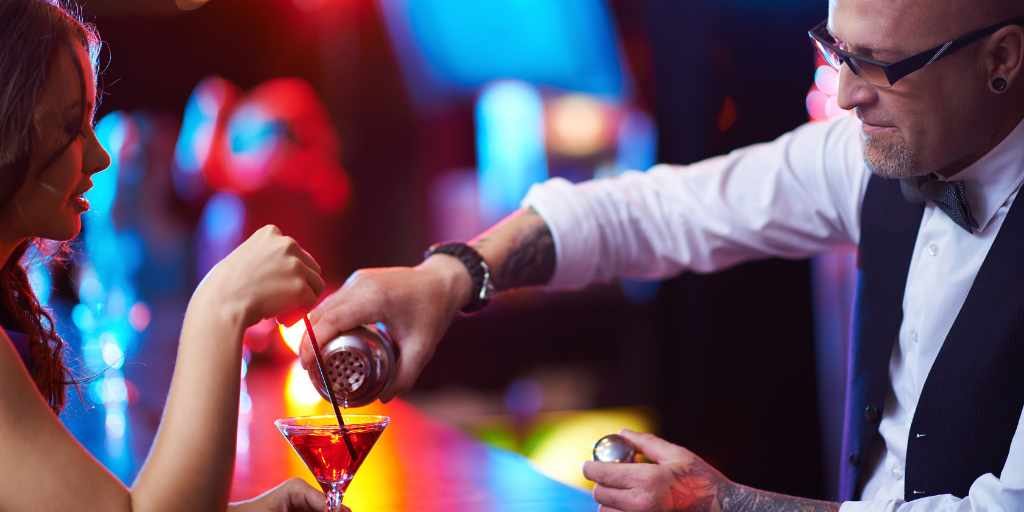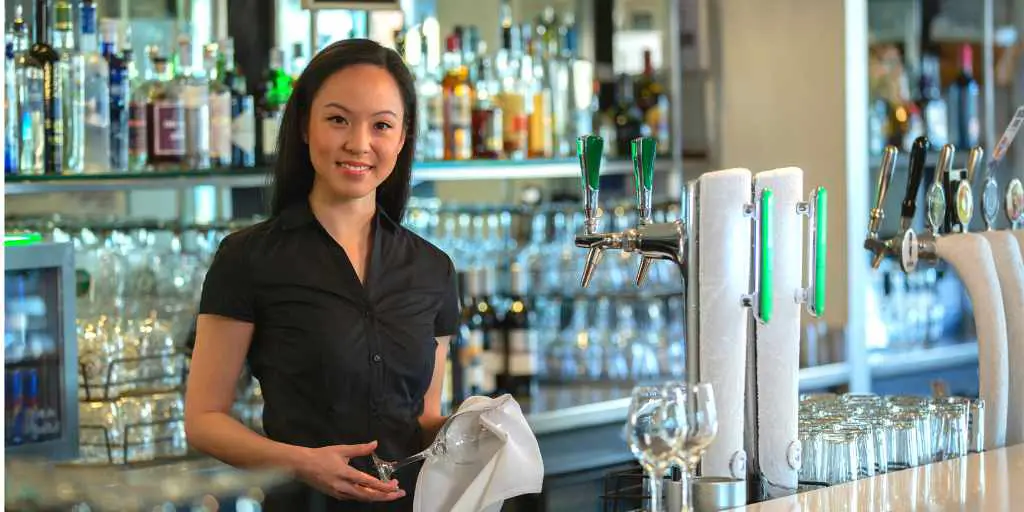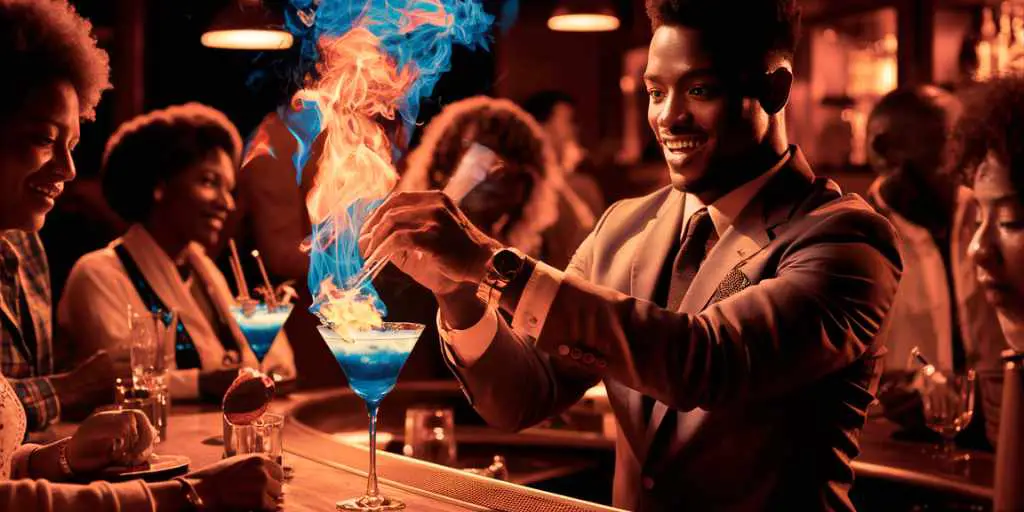Are you a beginner bartender looking for essential workplace tips to help you survive behind the bar? These bartending tips for beginners will give you the knowledge and confidence to excel in your new role.
This article will cover things you need to know to get started and succeed in the bartending world.
Four Bartending Tips for Beginners
Even if you’ve worked in other areas of the hospitality industry for a while, it’s important to remember some things.
It’s Not Just About Making Drinks
Bartending is not just about memorizing drink recipes. While it’s essential to have practical skills like pouring drinks, providing hospitable service is even more critical. A good bartender creates a unique and memorable experience for each customer.
Rather than focusing solely on memorizing drink recipes, focus on customer service to become a great bartender.
Customer Service is King
Bartending is all about hospitality and nailing customer service is crucial for success. Smile, stay calm, and offer solutions when dealing with upset customers. Remember, the customer is always right (even when they’re not). In extreme cases of abusive behaviour, it’s important to respect yourself and walk away.
…And Get To Know the Regulars
Great bartenders know their regulars. Learning their names, favorite drinks, and food orders creates a sense of community and makes customers feel welcome. Creating loyal regulars leads to repeat business, higher checks, and bigger tips.
Building relationships with regulars creates a sense of family and benefits everyone involved.
It’s a Team Sport
To be a star player in the hospitality industry, be reliable and a team player. Help out your coworkers and boost morale by lending a hand when needed. Being a team player and going the extra mile for customers and colleagues can lead to more opportunities and longevity in this exciting field.
Now let’s move on to some more specific areas…
Bar Workplace Tips
Let’s cover some workplace tips for finding your feet in a new bartending job.
The Work Environment

When bartenders first start their career, they often quickly learn a few essential things that can help them survive and thrive behind the bar like:
- Handling Intoxicated Customers: Working among heavily drinking people can be challenging, and it’s crucial to remain calm, friendly, and professional while dealing with demanding or difficult customers.
- Learning Industry Techniques and Lingo: Working behind a bar can be overwhelming, with new techniques, recipes, and industry terminology to learn. Familiarizing yourself with equipment such as a Boston Shaker is also essential to avoid spills or messes.
- Preparing Mentally and Physically: Being well-rested, wearing good and comfortable shoes for bartending, and staying energized throughout your shift is vital to keep up with the demanding job. You also want to keep your mind clear and focused, especially during busy periods, to maintain positive energy.
- Adapting to Long Hours and Demanding Work: Expect long hours of standing and moving around, and your body must adapt to the job’s demands. Although you might be familiar with standing, the nocturnal lifestyle of a bartender may still take some getting used to.
- Proper Keg Changing Techniques: Changing a keg requires proper training and practice. Without it, you may end up in an embarrassing situation, so make sure to receive adequate training to avoid any mess.
- Dealing with a New Clientele: Bartending attracts a different crowd, some nicer than others, and some can be difficult to handle, especially if intoxicated. You might have to cut them off after a drink or two.
Despite the challenges, bartending can be an exciting and rewarding job. The fast-paced environment, blaring music, and endless interactions with people can be addictive. The key is to remain focused, efficient, and professional while maintaining a friendly and welcoming customer atmosphere.
If You Don’t Know the Answer, Speak Up
Each bar has its own way of doing things, which might not be how it was taught in your bartender school. A few things to keep in mind can help you find your feet:
- Don’t be afraid to ask for help. Your manager and colleagues can provide training and guidance and are generally happy to answer your questions.
- Ask questions and speak up. It’s better to clarify things and be well-prepared than to be unsure during a busy shift.
- Be approachable and friendly. Greet guests with a smile, make eye contact, and let them know you’re there to help.
- Clarify drink orders you’re unfamiliar with. It’s better to take a moment to get it right than to serve something incorrect.
- Engage with customers and learn about their tastes. This can help you make better recommendations and improve your tips. Always remain professional and respectful.
Know When and How to Talk to Your Guests
Effective communication is key in the hospitality industry, and engaging with guests can make a big difference in their experience.
Here are some tips for knowing how and when to talk to your guests:
- Read the room: Pay attention to the atmosphere and the guests’ mood to approach them appropriately.
- Be approachable: Greet guests with a smile and make them feel welcome.
- Listen actively: Listen carefully and respond thoughtfully to show you’re engaged and interested in what they say.
- Avoid controversial topics: Keep conversations light and avoid topics that could be divisive or controversial.
- Respect boundaries: Be aware of personal space and don’t invade it.
Remember, the goal is to make guests feel comfortable and welcome, and knowing when and how to engage with them is an important part of achieving that goal.
Customer Safety
Ensuring the safety of customers is a top priority for bartenders. Here are some safety issues to watch for, along with some tips to prevent them:
- Over-serving: Bartenders must monitor customers’ alcohol consumption to prevent over-intoxication, which can lead to accidents, injuries, and legal issues. It’s important to serve drinks responsibly and not to continue serving to someone who appears to be overly intoxicated. Additionally, bartenders should be aware of signs of alcohol poisoning and know when to seek medical attention.
- Security concerns: Bartenders should be aware of potential problems brewing, such as aggressive customers or fights, and take appropriate action to prevent harm to themselves and others.
- Spiked Drinks: You should watch for patrons leaving drinks unattended or, worse yet, putting substances in other’s drinks. If you see someone’s drink left alone on your bar, consider placing a coaster on top of it or keeping an eye on it.
- Underage drinking: Bartenders should always check IDs and be aware of common fake ID tactics to prevent serving underage customers. In some cases, it may be necessary to refuse service to anyone who appears to be underage, even if they have an ID that appears valid. Overserving customers can have severe repercussions for the bar’s license, and your managers and bar owner should back you up.
By being vigilant, bartenders can create a safe and enjoyable environment for everyone.
Next, look at some equipment you should have at a bar.
Basic Bar Gear

Here are some essential bar tools that you should find in any bar.
- Cocktail Shaker: You can choose from two types of shakers. The Boston shaker, a two-piece shaker consisting of a mixing tin and a pint glass, is preferred by most bartenders in North America. The cobbler shaker is a three-piece shaker with a mixing tin, a cap with a built-in filter, and a lid.
- Strainer: If you use a Boston shaker or mixing glass, you will need a separate strainer. The Hawthorne strainer is a popular option, but having a Julep strainer can also be advantageous.
- Jigger: Jiggers are used for measuring and come with a cup on each end that makes it easy to measure a shot or half shot when mixing drinks. They are also useful when a cocktail recipe uses “parts” instead of volume measurements.
- Muddler: This tool is a wooden or stainless steel stick used to mash fresh produce and is essential for making cocktails like mojitos and mint juleps.
- Bar Blade: Also known as a speed opener, a bar blade is a flat, metal tool used to open beer bottles quickly and is preferred by bartenders over regular bottle openers.
In addition, you should also have a citrus juicer for freshly squeezed citrus juice, a cutting board and knife for cutting garnishes and muddling, and an ice bucket and tongs for keeping ice cold and easily accessible during service.
See this article for more bar equipment and tools and what they’re for.
Bar Lingo
Here are some common bar lingo terms and their meanings:
Well or Call Drink: Well drinks or Rail drinks are those where the customer doesn’t specify a brand, so the bartender chooses the whiskey, rum, or tequila from the well. When you order a specific brand of liquor, you’re ordering a “call drink,” such as a Jack and Coke (with Jack Daniel’s) instead of a generic Whiskey and Coke.
Neat, Up, or Straight Up: A drink served neat is poured directly from the bottle into a glass without any ice, water, or mixer. When a drink is served “up,” it means it has been shaken or stirred with ice and then strained into a glass without ice. On the other hand, a drink served “on the rocks” is poured over ice.
Chasers: A chaser is a drink, typically non-alcoholic, consumed immediately after taking a shot of liquor. The purpose of a chaser is to help neutralize the taste of the strong alcohol, making it more palatable.
Top-Shelf: When discussing liquor, “top-shelf” refers to the highest quality and most expensive brands. The name originates from placing these bottles on liquor store shelves, with the more affordable options at the bottom and the premium options on top to catch consumers’ attention.
The Many Uses of “Back”: A “back” is a drink served alongside the main drink in a separate glass, often a nonalcoholic beverage like water or soda. The “back bar” typically refers to the liquor displayed on a shelf behind the bartender. A “bar back” is a bar employee training to become a bartender, while “stick drinks” are muddled cocktails.
Virgin drinks: Virgin drinks are non-alcoholic cocktails, often made with the same ingredients as their alcoholic counterparts, except the alcohol portion is replaced with a flavoured mixer like ginger ale, ginger beer, or tonic water.
Tonic Back: A tonic back is a non-alcoholic drink, specifically tonic water, served alongside a main alcoholic beverage in a separate glass. It can be used as a palate cleanser or to dilute the alcoholic drink if desired.
If you’re looking for we’ve got an article on bartender lingo here.
Drink Tips

Here we’ll cover some of the language around cocktails and wine.
Cocktail vs Mixed Drink
The terms “cocktail” and “mixed drink” are often used interchangeably. Here are tips for understanding the difference between them:
Mixed drinks combine two or more ingredients and can be alcoholic or nonalcoholic, such as a John Collins, rum and Coke, Shirley Temple, or Arnold Palmer. They are often served over ice.
Cocktails are a specific type of mixed drink that typically includes liquor(s), a sweetener, bitters, and diluted ice, such as a martini. While the definition has expanded over time, cocktails are generally more complex and require additional preparation.
In summary, all cocktails are mixed drinks, but not all mixed drinks are cocktails.
Understanding Cocktail Recipe Lingo
When browsing cocktail recipes, you may come across some unfamiliar terms. Here are a few to know:
- Mixers: Nonalcoholic ingredients added to a mixed drink, such as syrups, fruit juices, and bitters.
- Dash and Splash: The smallest measurements used in a bar, often used interchangeably for ingredients that add accents to a drink. A dash is typically 1/32 of an ounce and is used for strong-flavoured ingredients like bitters. A splash is a larger amount and varies depending on the ingredient.
- Garnish: A fruit or other item used to adorn a drink and add visual appeal, sometimes also adding flavour.
Remember, while exact measurements are important in some recipes, the terms “dash” and “splash” are used loosely and can vary depending on the bartender or recipe.
The Six Basic Liquors

In the world of cocktails, six types of liquor form the foundation for many mixed drinks and liqueurs.
- Brandy: Distilled from fruits, typically grapes, brandy has a rich, fruity flavor and is often used in classic cocktails like the Sidecar and Brandy Alexander.
- Gin: Often distilled from grains, gin is flavoured with botanicals, most notably juniper, and is a key component in cocktails like the Martini and Gin and Tonic.
- Rum: Made by distilling sugar or molasses, rum is a sweet and versatile liquor that’s used in everything from tiki drinks to classic daiquiris.
- Tequila: A product of Mexico, tequila is distilled from the agave plant and has a distinctive earthy flavor. It’s a key ingredient in cocktails like the Margarita and Paloma.
- Vodka: The most popular liquor, vodka can be distilled from any number of ingredients, though grains and potatoes are most common. It’s used in a wide variety of cocktails, from the classic Screwdriver to the modern Cosmopolitan.
- Whiskey: A complex category with many styles and variations, all whiskies begin with a distillate of fermented grains. From there, the aging process and other factors create a wide range of flavors and characteristics. Whiskey is used in classic cocktails like the Old Fashioned and Manhattan.
Remember, while these six liquors are the basics. If you want to take your cocktails to the next level, don’t forget about the importance of liqueurs.
Liquor vs Liqueur
Liquor and liqueur are both alcoholic beverages but differ in ingredients and production processes.
Liquor, or spirits, is made by distilling fermented grains, fruits, or vegetables. Examples of liquors include whiskey, vodka, gin, and rum. Liquors typically have a higher alcohol content than other alcoholic beverages, ranging from 40% to 50% alcohol by volume (ABV).
Liqueur combines a distilled spirit with various flavourings, such as herbs, fruits, nuts, and sweeteners. Examples of liqueurs include Amaretto, Grand Marnier, and Kahlúa. Liqueurs typically have a lower alcohol content than liquors, ranging from 15% to 30% ABV.
Crème vs. Cream Liqueurs
These are two types of liqueurs that differ in their ingredients and texture.
Crème liqueurs are sweetened, flavoured liqueurs made with a base spirit, sugar, and cream or milk. They have a rich, creamy texture and are often used in cocktails or as a dessert ingredient. Examples of crème liqueurs include Crème de Menthe, Crème de Cassis, and Irish Cream.
Cream liqueurs, on the other hand, are similar to crème liqueurs but typically contain more cream than milk. They are also sweetened and flavoured but often blend whiskey and cream instead of a base spirit. Examples of cream liqueurs include Baileys Irish Cream, Amarula, and RumChata.
Common Cocktail Mistakes and How to Avoid Them
Here are some general tips for making cocktails:
- Shaking cocktails that should be stirred: Cocktails with juices, dairy, or egg whites should be shaken, while spirit-based cocktails should be stirred.
- Stirring too quickly or roughly: To stir a cocktail correctly, use a bar spoon and stir evenly and smoothly to avoid bruising the ingredients.
- Eyeballing ingredient amounts: Avoid pouring drinks by feel and use a measuring device to ensure accuracy and consistency.
- Using non-fresh ingredients: Use fresh ingredients like lemon instead of synthetic acids to ensure a high-quality drink.
- Incorrect muddling techniques: Muddling is crucial for some cocktails, like Mojitos, but avoid using excessive force, leading to unbalanced flavours. Clean the muddler in between uses.
Have the Classic Cocktails Down
Most bars will have a cocktail list that you’ll have to make their way, but here are ten classic cocktails you should probably have a handle on too.
- Gin and Tonic: A simple mix of gin, tonic water, and a slice of lime, served over ice.
- Old Fashioned: A mix of whiskey, sugar, bitters, and a citrus peel, served over ice.
- Martini: A combination of gin or vodka and dry vermouth, garnished with an olive or twist of lemon.
- Manhattan: Made with whiskey, sweet vermouth, and bitters, garnished with a cherry.
- Margarita: A mix of tequila, lime juice, and triple sec, served with salt on the rim of the glass.
- Negroni: Made with gin, Campari, and sweet vermouth, served with an orange peel.
- Daiquiri: A mix of rum, lime juice, and simple syrup served in a chilled glass.
- Sidecar: Made with cognac, Cointreau, and lemon juice, garnished with a sugar rim.
- Gimlet: A gin and lime juice mix, often sweetened with simple syrup.
- Whiskey Sour: A combination of whiskey, lemon juice, and sugar, served with a cherry and orange slice.
If you want to keep up with what cocktails are popular worldwide, Drinks International publishes a list of the best-selling cocktails each year. You’ll find both classic and modern cocktails on their lists.
Choose the Right Glassware and Utensils
Each cocktail has an ideal glass type. Familiarize yourself with at least three commonly used glasses:
- Martini glasses: Suitable for almost all short drink types.
- Juice cups: Ideal for cocktails like Long Island Iced Tea, Screwdriver, or Singapore Sling, which are long drinks with a significant amount of juice.
- Collins glasses: Used for cocktails with carbonated mixers.
Wine Serving Tips

Bartenders should be familiar with several aspects of wine and its service.
- Wine varieties: Understand the differences between red, white, rosé, and sparkling wines, as well as the primary grape varieties used in each type. See the section below for the differences.
- Wine regions: Familiarize yourself with the major wine-producing regions worldwide, as the region can significantly influence a wine’s taste and quality.
- Wine and food pairings: Learn which wines pair well with various foods to offer helpful suggestions to guests who seek advice on pairing options.
- Serving temperature: Serve red wines slightly below room temperature (around 60-65°F), white and rosé wines chilled (around 45-50°F), and sparkling wines well-chilled (around 40-45°F).
- Proper glassware: Use appropriate wine glasses for different types of wines—typically, larger glasses for reds, smaller glasses for whites, and flutes for sparkling wines.
- Opening and presenting: Know how to open wine bottles skillfully using a corkscrew, and always present the label to the customer before opening.
- Decanting: Learn when and how to decant wines, particularly older red wines with sediment, to improve taste and presentation. And learn how to clean a decanter, too.
- Pouring technique: Pour wine gently down the side of the glass to avoid creating bubbles or splashing, and serve the appropriate amount—about 5-6 ounces for a standard pour.
- Using a towel: Always have a clean, folded towel on hand when serving wine. Use it to wipe the bottle’s neck after opening to remove any residue and to catch any drips when pouring. Hold the bottle with the towel to ensure a firm grip and prevent fingerprints on the bottle.
- Turning the bottle: When finishing a pour, slightly twist the bottle as you lift it away from the glass. This technique helps prevent drips and gives the pour a clean, polished finish.
- Preserving open bottles: Use proper techniques and tools, such as vacuum pumps or inert gas systems, to preserve open bottles of wine and maintain their quality for as long as possible.
- Wine storage: Store wine bottles horizontally in a cool, dark place with consistent temperature and humidity to ensure optimal ageing and preservation.
What Are the Differences Between Red, White, Rosé, Sparkling and Fortified Wines?
The main differences between red, white, rosé, and sparkling wines are based on the grape varieties, winemaking processes, and characteristics of each type:
Red wine is made from dark-coloured grape varieties and its colour comes from the grape skins being included during fermentation. The tannin content in red wines comes from the skins too. Popular red grape varieties include Cabernet Sauvignon, Merlot, Pinot Noir, Syrah/Shiraz, and Zinfandel.
White wine is made from white (green) or dark-coloured grapes with the grape skins removed before fermentation. This results in a lighter colour and body compared to red wines. Popular white grape varieties include Chardonnay, Sauvignon Blanc, Riesling, Pinot Grigio/Gris, and Gewürztraminer.
Rosé wine gets its distinct pink colour from limited contact with grape skins during winemaking. This brief skin contact imparts some colour and tannins, but not as much as in red wines. Rosés can be made from various grape varieties, such as Grenache, Syrah, Pinot Noir, and Sangiovese.
Sparkling wine is characterized by its effervescence from carbon dioxide bubbles produced during a secondary fermentation process. They can be made from various grape types, with the most famous being Champagne, made primarily from Chardonnay, Pinot Noir, and Pinot Meunier grapes in the Champagne region of France.
Fortified wine has additional alcohol added to it during or after fermentation. This increases their alcohol content and often enhances their flavour, aroma, and shelf life. Examples of fortified wines include Port, Sherry, Madeira, and Marsala.
Aromatized wine is a type of fortified wine infused with various herbs, spices, fruits, and other botanicals to enhance its flavour and aroma. These wines typically have a lower alcohol content than other fortified wines and are often enjoyed as an aperitif or digestif. Vermouth, Quinquina, and Americano are some examples of aromatized wines.
Tips for Cleaning Glassware
Proper cleaning of bartending tools is crucial to maintain the smell and taste of drinks. Pay attention to these points for proper cleaning:
- Avoid metal wires and thick brushes: They can scratch and leave fine lines on the glass surface. Use a sponge or cloth for wide-mouth, short cups and brushes for narrow-mouth, long cups.
- Don’t fill glasses directly with ice: This is unprofessional and dangerous because the fragile edges of the glass may break upon contact with ice.
- Dry glasses after washing: If not dried, irregular scales can appear on the walls of glasses or beer mugs after air-drying. Similarly, sugary or high-consistency drinks can leave a residue if washed with water only.
- Store glasses in a ventilated place: Keeping them in closed cabinets can attract odours. Wipe any dust on the surface with an electrostatic cloth before use.
Conclusion
In conclusion, these bartending tips for beginners provide a comprehensive guide to help you excel in the bartending world. From handling demanding customers to staying organized during a busy shift, these workplace tips cover everything you need to know to get started.
Understanding bar lingo, using the proper equipment, making classic cocktails, and serving wine correctly are crucial elements to ensure that customers have the best possible experience. By following these tips, you can become a successful bartender and thrive in this exciting and rewarding industry.



